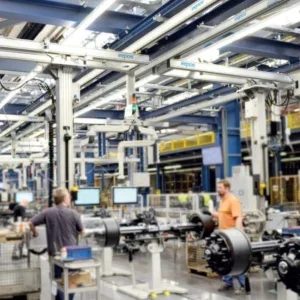The crane takes up the containers with a spreader
beam and transfers them to goods wagons. They are then transported to the Schwandorf waste-fired power station where the waste is heat treated.
The reloading station is in operation every working day
so high availability and minimum downtime is essential for cost-effective operation. In Wörth, approximately five goods wagons and 10 special containers are constantly on the move. A crane system was thus required for loading the containers, which can weigh up to 25t.
The crane was to lift the containers, transport them to
the railway siding and lower them onto goods wagons.
The crane system was designed as a double girder overhead travelling crane with 10,900mm (around 36ft) span. The SWL of 38,000kg took into account, in addition to the live load of 25t, the deadweight of the off-standard spreader beam for lifting the containers. The spreader beam was equipped with a powered slewing drive so the containers could be rotated horizontally if necessary. The 42m long crane runway was planned together with the necessary steel supports. It included a maintenance catwalk over its whole length and an access ladder with a protective cage. Access from the catwalk to the maintenance platform on the crane bridge is via an electrically monitored door which disconnects the crane when it is open and thus permits safe access.
The four-point load take-up was realised with two electric wire rope hoists from the “field-proven” AS7 series. Each wire rope hoist was equipped with two load ropes which are suspended from return pulleys on the spreader beam and enable the load to be transported without swinging. The integrated SSC load cumulation enhances safety in operation, calculating and monitoring the suspended load on all four ropes.
Practically swing-free transportation of the huge containers was an important requirement, while the crane runway was to be free standing. The rope suspensions are height-adjustable so that the “perfectly horizontal” position of the spreader beam is ensured. The SMC multicontroller offers even greater safety in operation, electronically monitoring the temperature of the motors and braking operations and motor starts, and calculating the remaining service life of the hoists on the basis of loads and operating times.
The hoist motors permit speeds of 5 and 0.8m/min. With a duty cycle of a total of 60% DC, the drives are classified in 4m in compliance with FEM and provide additional power reserves. Crane travel up to 40m/min between the container storage area and the railway siding is smooth and stepless with frequency inverters of the SFD series controlling the four travel drives of 2.2kW each.
The track guiding system with lateral guide rollers “guarantees” optimum running qualities. The cranes are operated centrally from a control room in the building by means of radio remote control, with a choice of manual or automatic operation. A contact-free electronic position encoding system positions the crane with millimetre accuracy above the stopping points. A rail is mounted along the crane runway which has holes punched into it. The crane is equipped with an optical sensor that reads the length and position of the holes. The signals from the sensor are evaluated by the crane electronics and are used to determine the current crane position.
All the crane system’s equipment was fitted out with weatherproof features – from galvanised weather protection plates to high-quality surface treatment, to special light-resistant cables.
Further design features include cast iron rope guides, covers on rope drums and control panels and rail cleaners in front of the wheels to ensure ice and snowfree travel on the crane rail. Temperature-resistant rope guides in cast metal are standard features of Stahl hoists.
The system was built in the Ettlingen factory, delivered in May 2006 and erected on the ready installed runway at the site in Lower Bavaria. Since then, the system has been in operation “without downtime.”
Preventive maintenance is carried out from the Stahl CraneSystems branch office in Munich. The programme is described by Stahl as a “custom” maintenance schedule.
The double girder overhead travelling crane complete with spreader beam and crane runway stahl 1 After being loaded onto the goods wagons standing ready, the containers start their journey to the Schwandorf waste-fired power station stahl 5 A position encoding system was used for positioning the spreader beam over the containers stahl 2 The wire rope hoists of the AS 7 series were provided with off-standard features to make them suitable for outdoor use stahl 3 A total of four load take-up points permits practically swing-free and thus safe transportation stahl 4






